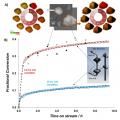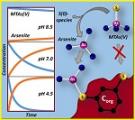Nanotechnology, which focuses on materials that measure between 1 and 100 nanometers in at least one dimension, is being applied to diverse areas of research including medicine, electronics, and biology. Yet it is unclear how these engineered nanomaterials might interact with and affect environments and ecosystems.
Approximately 1,700 scientists visit SSRL annually to conduct experiments in broad disciplines including life sciences, materials, environmental science, and accelerator physics. Science highlights featured here and in our monthly newsletter, Headlines, increase the visibility of user science as well as the important contribution of SSRL in facilitating basic and applied scientific research. Many of these scientific highlights have been included in reports to funding agencies and have been picked up by other media. Users are strongly encouraged to contact us when exciting results are about to be published. We can work with users and the SLAC Office of Communication to develop the story and to communicate user research findings to a much broader audience. Visit SSRL Publications for a list of the hundreds of SSRL-related scientific papers published annually. Contact us to add your most recent publications to this collection.
Hydrogen sulfide (H2S) is a poisonous and corrosive gas created in industrial and natural systems. Copper oxide (CuO), a crystalline solid, can be used to clean H2S from emissions by forming various copper sulfide species, a reaction that is thermodynamically favorable but often does not go to completion in industrial applications.
Lithium ion batteries are widely used in electronic devices and vehicles because of their high energy density. Unfortunately, lithium is not an abundant element on Earth, so demand is mounting for an alternative battery that has high energy density but made with more sustainable materials.
Metastable materials are materials that exist in their higher-energy configurations. They will eventually transform into their lowest energy form, given a certain amount of time. The classic example is diamond, which given enough time will change into graphite. They can have desired functionalities that make them useful in a variety of applications, such as in electronics, batteries, and catalysts. However, making metastable materials is not an easy job.
The more widespread use of solar electricity is not currently limited by the technology for generating energy from sunlight but by the storage of that energy, so that it can be used when needed. Converting water to O2 and H2 via the oxygen evolution reaction (OER) is a fossil fuel free way to store energy for later use; catalysts that improve the efficiency of OER are being sought. Manganese oxide (MnO2) films are good catalysts of OER, with additional benefits of being acid-stable and earth abundant.
Arsenic is a well-known toxin that can contaminate our drinking supplies. Understanding how arsenic finds its way into drinking water requires research into its interaction with environmental conditions that affect redox reactions, including interactions with iron, sulfur, and carbon.
Local differences in a battery’s structure and chemistry can lead to problems with function, such local over-charging or under-charging, and can affect the ability to hold charge. Understanding these heterogeneities is important for engineering well-functioning batteries but they are difficult to measure and study. Scientists usually use either an electrochemical process or a chemical process to prepare materials when studying lithium ion battery heterogeneity at different state of charge. Both of these have flaws: the electrochemical process is close to real-life behavior but experiments may be complicated by structural complexity, and the chemical delithiation process creates a simpler structure but may not properly reflect real-world applications.
Organic semiconductors are crystals or thin films composed of carbon-based molecules bonded together though covalent “π-bonds” that provide conductivity. These organic semiconductors can be used for organic photovoltaic (OPV) devices, which show promise as an alternative to traditional solar cells with possible applications in building integrated photovoltaics. As with conventional semiconductors, such as silicon, doping organic semiconductors with specific impurities is needed to improve the electrical properties. One effective method for doping, using 12-molybdophosphoric acid hydrate (PMA), was discovered recently but requires the use of the unstable solvent nitromethane.
Polymorphism is a fascinating natural phenomenon across many areas of materials science – from small molecules in chemistry, to minerals in geology, to drugs in pharmaceutical industry, to solid-state materials in electronics. High-density polymorphs with unique properties, such as a transparent insulating form of sodium (1) are routinely synthesized under compressive strain at very high pressure. In contrast, applying large negative pressure is very difficult, because large tensile strain usually causes materials to rupture. This logically leads to a question: how could negative pressure polymorphs be synthesized and what functional properties would such unusual materials have?
CoCrMo-based metal-on-metal hip implants were introduced, particularly for younger patients, due to their superior wear resistance and theoretical mechanical advantages over other hip implant materials (especially the most commonly used metal-on-polyethylene). However, these CoCrMo-based implants suffered an unexpectedly high failure rate1 raising concerns over their safety, and leading to considerable attention in the literature on explaining the reasons behind their failure.














